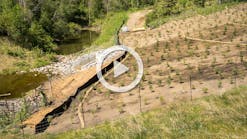
May 16–23 has been designated Infrastructure Week in the US, an attempt to educate the public—and the policymakers—about the desperately poor state of much of the nation’s infrastructure and the need to invest in improving it.
The problem isn’t new. For years the American Society of Civil Engineers has issued a report card on America’s infrastructure, grading it in several categories such as roads, railroads, bridges, ports, dams and levees, energy systems, drinking water, handling of solid waste and hazardous waste, and wastewater. The most recent report card, in 2013, gave an overall grade of D+, and ASCE estimated we need to invest $3.6 trillion in our infrastructure by 2020. This article in the latest issue of Water Efficiency magazine details some recent problems with failed water supply pipes and how cities are paying for repairs and prioritizing what to tackle first.
May 16–23 has been designated Infrastructure Week in the US, an attempt to educate the public—and the policymakers—about the desperately poor state of much of the nation’s infrastructure and the need to invest in improving it. The problem isn’t new. For years the American Society of Civil Engineers has issued a report card on America’s infrastructure, grading it in several categories such as roads, railroads, bridges, ports, dams and levees, energy systems, drinking water, handling of solid waste and hazardous waste, and wastewater. The most recent report card, in 2013, gave an overall grade of D+, and ASCE estimated we need to invest $3.6 trillion in our infrastructure by 2020. This articlein the latest issue of Water Efficiency magazine details some recent problems with failed water supply pipes and how cities are paying for repairs and prioritizing what to tackle first. [text_ad] As critical as the water supply is, an even more frightening problem might be the state of dams in US; their failure can cause death and property loss on a tremendous scale. In a bloglast month, I wrote about the lack of inspection of many of the nation’s dams and mentioned an articlein Stormwater magazine on dam breach analysis for small stormwater management ponds. This is a necessary and important thing to do. But what happens when the dam is something much larger than a typical stormwater structure?Unfortunately we might soon be reading about the effects of a larger dam breach. This one isn’t in the US—a reminder that we’re not the only ones who’ve neglected our infrastructure—but in Iraq, upstream from that country’s second-largest city, Mosul. As this article explains, the 30-year-old dam is in bad shape and there has been no money to fix it; for years the government has been plugging fissures in the eroding gypsum base beneath the dam as they occur. When ISIS seized the dam a year and a half ago, even that patchy maintenance ceased. After the government regained control of the dam, it found necessary equipment had gone missing and repairs since then have been sporadic. “If this dam were in the United States, we would have drained the lake behind it,” the commander of the American forces in Iraq is quoted as saying in the article. But doing so would deprive millions of people of drinking water. If the dam fails, it’s estimated that Mosul would be quickly submerged, half a million people would be in danger, and a million more left homeless. The World Bank has now provided $200 million for emergency repairs, and an Italian firm is under contract to provide a more lasting solution.What are the most serious infrastructure problems in your area? How aware do you think the public is of the need for repairs and upgrades, and is it a priority for most of them?As critical as the water supply is, an even more frightening problem might be the state of dams in US; their failure can cause death and property loss on a tremendous scale. In a blog last month, I wrote about the lack of inspection of many of the nation’s dams and mentioned an article in Stormwater magazine on dam breach analysis for small stormwater management ponds. This is a necessary and important thing to do. But what happens when the dam is something much larger than a typical stormwater structure?
Unfortunately we might soon be reading about the effects of a larger dam breach. This one isn’t in the US—a reminder that we’re not the only ones who’ve neglected our infrastructure—but in Iraq, upstream from that country’s second-largest city, Mosul. As this article explains, the 30-year-old dam is in bad shape and there has been no money to fix it; for years the government has been plugging fissures in the eroding gypsum base beneath the dam as they occur. When ISIS seized the dam a year and a half ago, even that patchy maintenance ceased. After the government regained control of the dam, it found necessary equipment had gone missing and repairs since then have been sporadic. “If this dam were in the United States, we would have drained the lake behind it,” the commander of the American forces in Iraq is quoted as saying in the article. But doing so would deprive millions of people of drinking water. If the dam fails, it’s estimated that Mosul would be quickly submerged, half a million people would be in danger, and a million more left homeless. The World Bank has now provided $200 million for emergency repairs, and an Italian firm is under contract to provide a more lasting solution.
What are the most serious infrastructure problems in your area? How aware do you think the public is of the need for repairs and upgrades, and is it a priority for most of them?Janice Kaspersen
Janice Kaspersen is the former editor of Erosion Control and Stormwater magazines.






